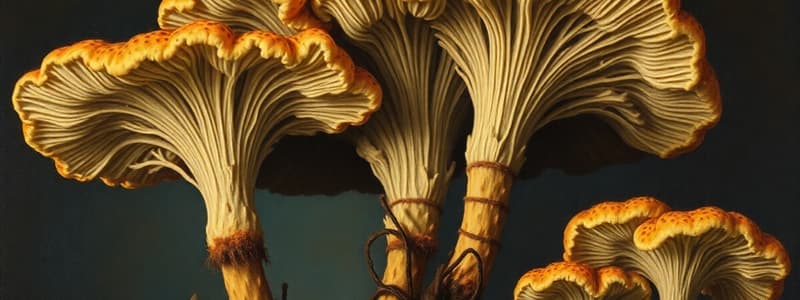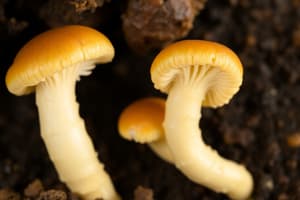Podcast
Questions and Answers
In a patient diagnosed with rhinocerebral mucormycosis, which of the following treatment strategies is MOST critical for improving the likelihood of a positive outcome?
In a patient diagnosed with rhinocerebral mucormycosis, which of the following treatment strategies is MOST critical for improving the likelihood of a positive outcome?
- Providing supportive care, including nutritional support and pain management, while awaiting spontaneous resolution.
- Administering high-dose amphotericin B combined with surgical removal of necrotic tissue and correction of predisposing conditions. (correct)
- Initiating a course of broad-spectrum antibiotics to prevent secondary bacterial infections.
- Prescribing a combination of antiviral medications to combat any potential viral co-infections.
A patient with a history of tuberculosis presents with a pulmonary aspergilloma. Which diagnostic finding would be MOST indicative of this condition?
A patient with a history of tuberculosis presents with a pulmonary aspergilloma. Which diagnostic finding would be MOST indicative of this condition?
- A chest X-ray revealing a radiodense structure that shifts position with patient movement. (correct)
- Elevated levels of IgE specific for Aspergillus antigens in serum.
- Septate hyphae forming V-shaped branches at 45-degree angles in lung tissue.
- Isolation of Aspergillus species from sputum cultures with no corresponding hyphae in tissue samples.
An AIDS patient undergoing antiretroviral therapy begins to exhibit an inflammatory response with increased CD4 count after being treated for cryptococcal meningitis. This scenario is MOST consistent with which of the following conditions?
An AIDS patient undergoing antiretroviral therapy begins to exhibit an inflammatory response with increased CD4 count after being treated for cryptococcal meningitis. This scenario is MOST consistent with which of the following conditions?
- A secondary bacterial infection triggered by the improved immune function.
- A paradoxical worsening of the cryptococcal infection due to drug resistance.
- Immune Reconstitution Inflammatory Syndrome (IRIS). (correct)
- An allergic reaction to the antifungal medications used to treat the meningitis.
A patient is suspected of having Pneumocystis pneumonia (PCP). If ergosterol is absent, why would ergosterol-inhibiting antifungals be ineffective?
A patient is suspected of having Pneumocystis pneumonia (PCP). If ergosterol is absent, why would ergosterol-inhibiting antifungals be ineffective?
A patient presents with suspected Pneumocystis pneumonia (PCP). What finding on a chest X-ray would lead you to suspect PCP?
A patient presents with suspected Pneumocystis pneumonia (PCP). What finding on a chest X-ray would lead you to suspect PCP?
A patient with uncontrolled diabetes mellitus develops rhinocerebral mucormycosis. What aspect of the patient's diabetic condition MOST directly contributes to the pathogenesis of this infection?
A patient with uncontrolled diabetes mellitus develops rhinocerebral mucormycosis. What aspect of the patient's diabetic condition MOST directly contributes to the pathogenesis of this infection?
Which of the following characteristics BEST differentiates Aspergillus hyphae from Mucorales hyphae under microscopic examination?
Which of the following characteristics BEST differentiates Aspergillus hyphae from Mucorales hyphae under microscopic examination?
In a patient with suspected cryptococcal meningitis, which diagnostic test on cerebrospinal fluid (CSF) provides the MOST rapid and specific identification of the causative organism?
In a patient with suspected cryptococcal meningitis, which diagnostic test on cerebrospinal fluid (CSF) provides the MOST rapid and specific identification of the causative organism?
A patient with AIDS presents with a subclinical lung infection caused by Cryptococcus neoformans. What immunological defect is MOST responsible for the dissemination of this infection to the brain, resulting in cryptococcal meningitis?
A patient with AIDS presents with a subclinical lung infection caused by Cryptococcus neoformans. What immunological defect is MOST responsible for the dissemination of this infection to the brain, resulting in cryptococcal meningitis?
A clinical laboratory is investigating a hospital outbreak of Mucorales infections among immunocompromised patients. What environmental source is MOST likely to be the origin of the fungal spores causing these infections?
A clinical laboratory is investigating a hospital outbreak of Mucorales infections among immunocompromised patients. What environmental source is MOST likely to be the origin of the fungal spores causing these infections?
Flashcards
Opportunistic Mycoses
Opportunistic Mycoses
Fungal infections in immunocompromised individuals, caused by typically harmless fungi.
Mucormycosis
Mucormycosis
Infection caused by Mucor, Rhizopus, Apophysomyces and Rhizomucor species, often affecting diabetics.
Rhinocerebral Mucormycosis
Rhinocerebral Mucormycosis
A severe form of mucormycosis that rapidly invades the sinuses, orbits, palate, and brain, particularly in diabetic patients.
Aspergillosis
Aspergillosis
Signup and view all the flashcards
Forms of Aspergillosis
Forms of Aspergillosis
Signup and view all the flashcards
Aspergilloma
Aspergilloma
Signup and view all the flashcards
Cryptococcal Meningitis
Cryptococcal Meningitis
Signup and view all the flashcards
Cryptococcus neoformans
Cryptococcus neoformans
Signup and view all the flashcards
Pneumocystis Pneumonia (PCP)
Pneumocystis Pneumonia (PCP)
Signup and view all the flashcards
PCP Diagnosis
PCP Diagnosis
Signup and view all the flashcards
Study Notes
- Opportunistic mycoses target individuals with weakened immune systems.
Mucormycosis
- Primarily caused by Mucor and Rhizopus species, and sometimes by Apophysomyces and Rhizomucor species.
- These species are saprophytic, non-dimorphic, and possess aseptate hyphae.
- Risk factors include diabetes (especially ketoacidosis), burn injuries, bone marrow transplants, and leukemia.
- Rhinocerebral mucormycosis is a rapidly fatal form common in diabetic patients, where mold spores invade blood vessels supplying the brain.
- Infection starts in the nasal mucosa or sinuses, then progresses to the orbits, palate, and brain.
- Treatment involves high-dose amphotericin B, surgical removal of necrotic tissue, and correction of predisposing conditions.
Aspergillosis
- Primarily caused by Aspergillus fumigatus, among other Aspergillus species.
- Aspergillus species are filamentous molds, not dimorphic, and produce conidiospores.
- Can cause infections of the skin, sinuses, eyes, and ears, as well as fungus balls in the lungs and allergic bronchopulmonary aspergillosis.
- Fungal sinusitis is commonly caused by Aspergillus.
- Acute invasive aspergillosis is a severe form originating in the lungs, potentially disseminating to the brain and gastrointestinal tract.
- Aspergilloma is a non-invasive lung infection forming a mass of hyphal tissue in pre-existing lung cavities, visible on chest X-rays.
- Allergic bronchopulmonary aspergillosis (ABPA) is a hypersensitivity reaction to Aspergillus in the bronchi.
- Diagnosis involves detecting hyphae in tissue and isolating the organism from clinical samples.
- Aspergillus hyphae are septate and branch at 45-degree angles.
- Colonies display radiating chains of conidia.
- ABPA patients show elevated IgE levels specific for Aspergillus antigens and eosinophilia.
- Treatment involves amphotericin B and surgical removal of fungal masses.
- Transmission occurs via airborne asexual sporangiospores.
- These organisms are found in dust, soil, and decomposing organic matter.
- Hospital outbreaks can be linked to dust from construction work.
- Risk factors include immunocompromised and neutropenic states.
- CT scans can reveal involvement of the paranasal sinuses and periorbital soft tissue.
- Staining (PAS) shows irregular, broad hyphae with right-angle branching.
- Rhizopus species' rhizoids are visible on blood vessel staining.
Cryptococcosis
- Cryptococcus neoformans, a yeast, causes cryptococcal meningitis.
- It is the most common life-threatening basidiomycete fungal disease worldwide.
- Not dimorphic, it is an oval budding yeast with a wide polysaccharide capsule.
- Forms a narrow-based bud.
- It is abundant in soil with bird droppings, especially pigeon droppings.
- Disease primarily affects patients with reduced cell-mediated immunity, especially those with AIDS.
- HIV-related cryptococcosis is the second most common fungal infection after candidiasis.
- Cryptococcal meningitis is an AIDS-defining condition.
- Human infection results from inhalation.
- No human-to-human transmission occurs.
- The most common form is a mild, subclinical lung infection.
- In immunocompromised patients, it often disseminates to the brain, causing cryptococcal meningitis.
- It can cause immune reconstitution inflammatory syndrome (IRIS) upon antiretroviral therapy due to increased CD4 count.
- Diagnosis involves microscopic examination of spinal fluid mixed with India ink to visualize the capsule.
- Mucicarmine, Periodic acid-Schiff (PAS), and Methenamine silver stains are useful in lung tissue.
- Treatment involves antifungal drugs such as amphotericin B and flucytosine.
- Treatment depends on the disease stage, infection site, and patient's immune status.
Pneumocystis Pneumonia (PCP)
- Pneumocystis jirovecii causes pneumonia and is a disc-shaped yeast-like fungus.
- Previously known as Pneumocystis carinii.
- Classified as a yeast based on molecular analysis, but has protozoan characteristics.
- Acquired by inhalation, it is ubiquitous in nature.
- Not transmitted person to person.
- Disease in immunodeficient patients results from reactivation of dormant cells in the lungs.
- Most immunocompetent individuals have asymptomatic infections.
- Encysted forms induce alveolar inflammation, leading to exudate production that blocks gas exchange.
- Symptoms includes fever, nonproductive cough, and dyspnea.
- If untreated, mortality approaches 100%.
- Diagnosis is based on microscopic examination of cysts in lung tissue.
- Elevated lactic acid dehydrogenase (LDH) levels (>220 U/L) are common in PCP patients.
- Infection is generally confined to the lungs.
- Chest X-ray shows a patchy or ground-glass appearance, sparing the lower lobes.
- Bilateral rales are heard on auscultation.
- Trimethoprim-sulfamethoxazole is the first-line treatment and prophylaxis, as ergosterol is absent in the cell wall, other antifungals are ineffective.
- One of the most common opportunistic diseases in individuals infected with HIV.
- The most common AIDS-defining opportunistic infection.
Studying That Suits You
Use AI to generate personalized quizzes and flashcards to suit your learning preferences.



